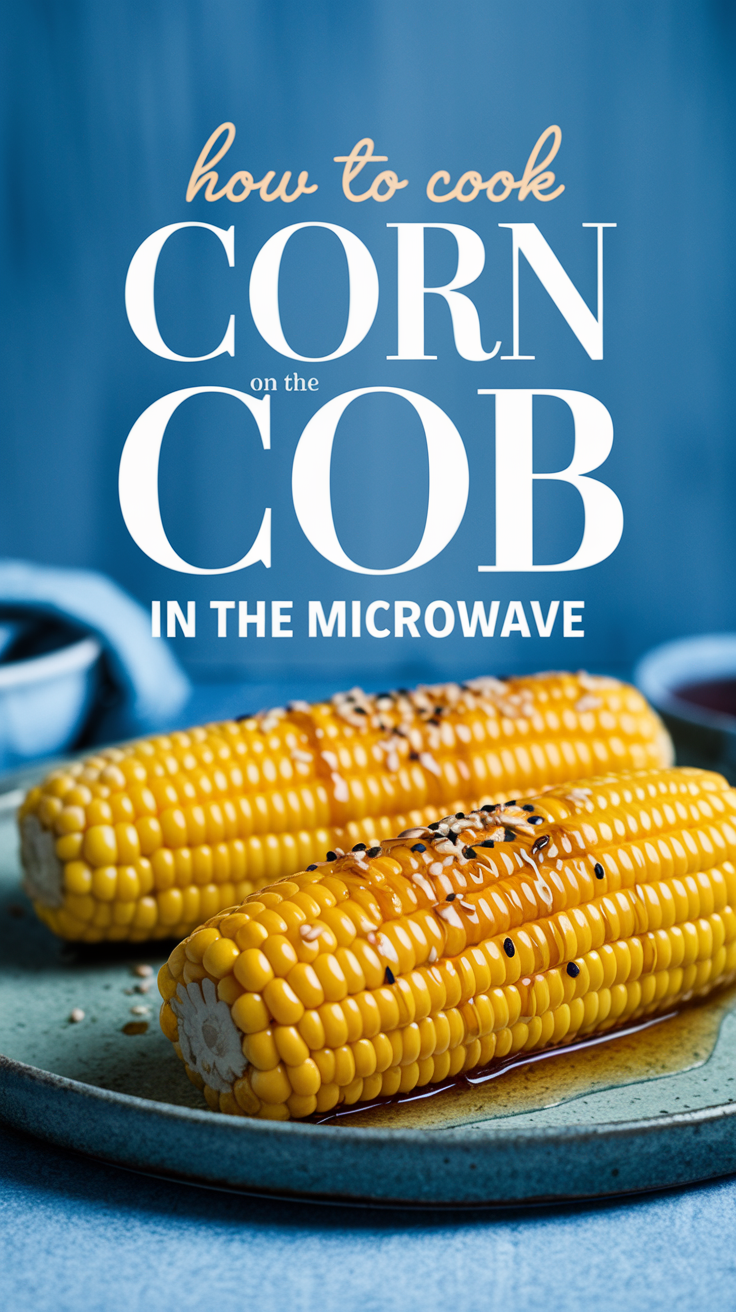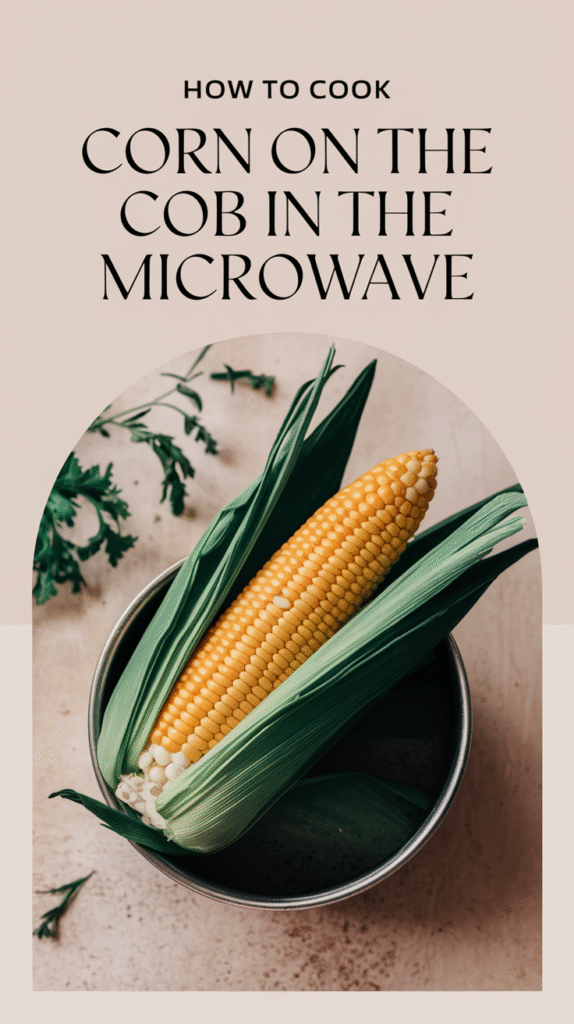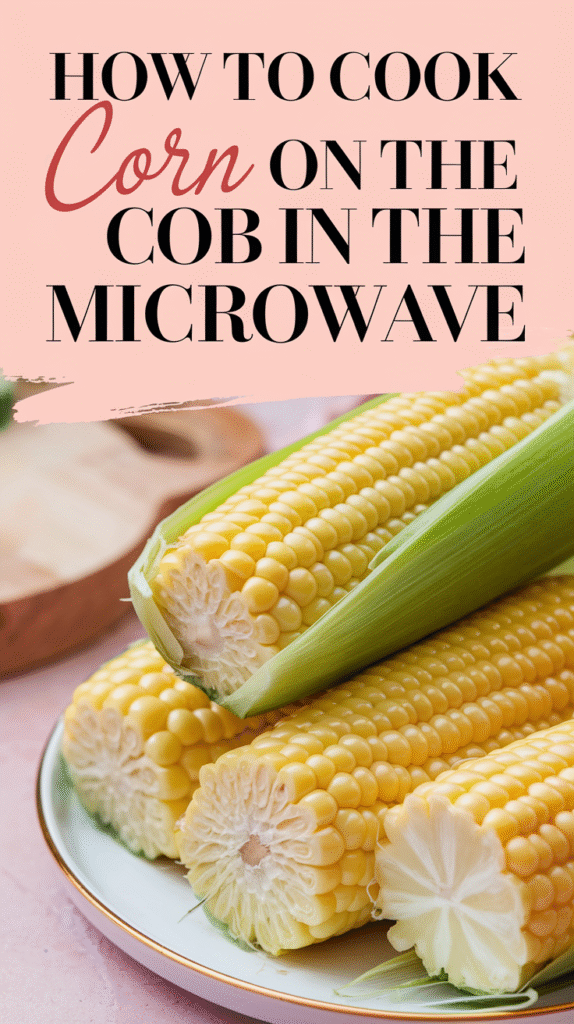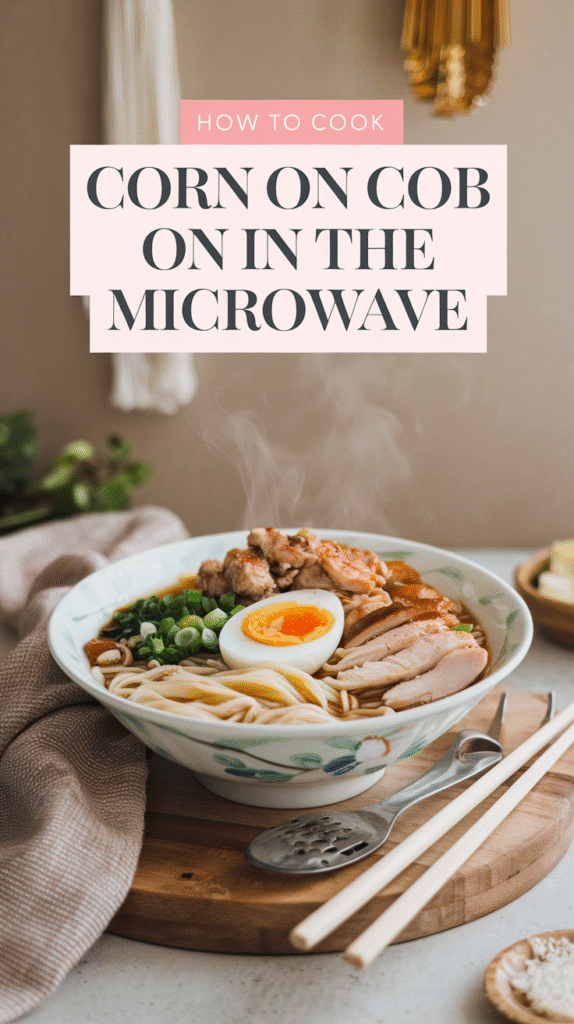Corn on the cob is a delightful treat, especially during summer barbecues and family gatherings. Cooking it in the microwave is one of the quickest and easiest methods to achieve perfectly tender kernels while preserving their natural sweetness. Here are some simple methods to cook corn on the cob in the microwave.
Method 1: Whole Ears of Corn
This method is perfect if you want the maximum flavor without much fuss.
- Choose fresh corn on the cob. Look for ears with bright green husks and plump kernels.
- Leave the husks on the corn. They will help keep the moisture in and prevent the corn from drying out.
- Place the corn on a microwave-safe plate. If you have multiple ears, arrange them in a circular pattern for even cooking.
- Microwave on high for 3 to 5 minutes per ear. If cooking more than one ear, add an additional minute for each extra ear.
- Carefully remove the corn from the microwave using oven mitts, as it will be very hot. Let it cool for a moment before carefully peeling back the husks. Enjoy with butter and seasonings of your choice!
Method 2: Corn on the Cob Wrapped in a Damp Paper Towel
This method is ideal if you prefer to husk the corn before cooking.
- Shuck the corn, removing the husk and silk completely.
- Wrap each ear of corn in a damp paper towel. This helps create steam and ensures the corn cooks evenly.
- Place the wrapped corn in a microwave-safe dish. Again, arrange them to avoid overcrowding.
- Microwave on high for 2 to 4 minutes. Start checking at 2 minutes, and increase in 30-second intervals until the corn is tender.
- Unwrap the corn carefully, as steam will escape. Season and serve!
Method 3: Cooking with a Corn on the Cob Holder
If you have corn on the cob holders, this method is particularly fun and effective.
- Shuck the corn and insert the corn holders into each end of the cob.
- Place the corn directly in the microwave without any wrapping.
- Microwave on high for 3 to 5 minutes, depending on the number of cobs and your microwave’s wattage.
- Allow the corn to cool for a minute, then enjoy it right off the holders!
Tips for Perfect Corn on the Cob in the Microwave
- For enhanced flavor, try adding spices or herbs to the corn after cooking.
- Adding a little butter or oil before wrapping or cooking can contribute to juiciness.
- Feel free to experiment with cooking times based on your microwave’s power; 800 watts and below may require longer cooking times.
- Microwaving only 1 or 2 ears at a time is ideal for even cooking—more might lead to uneven textures.
What to Serve with Corn on the Cob
Corn on the cob pairs well with a variety of dishes. Consider serving it alongside:
- Grilled meats, such as steak, chicken, or fish
- Salads, providing a refreshing contrast
- Vegetable dishes for a balanced meal
Cooking corn on the cob in the microwave not only saves time but also locks in its sweetness, resulting in a delicious side dish. Whether you enjoy it plain, topped with butter, or seasoned with spices, microwave corn on the cob is simple and satisfying.
For more details and tips on cooking corn on the cob, visit Cooking with Corn or learn more about microwave techniques at Microwave Cooking.
Flavorful Toppings to Enhance Your Microwave Corn on the Cob
When it comes to enjoying corn on the cob, cooking it in the microwave is quick and easy. But why stop there? Adding flavorful toppings can elevate this simple dish to something extraordinary. Here are some delicious toppings you can try to enhance your microwave corn on the cob experience.
Classic Butter and Seasonings
Nothing beats the tradition of butter on corn on the cob. Here’s a quick way to prepare it:
- 1 tablespoon of butter
- 1/4 teaspoon of salt
- Optional: A sprinkle of pepper or garlic powder
Simply melt the butter in the microwave and mix in the salt and other seasonings. Brush this mixture over your hot corn for a comforting taste.
Cheesy Goodness
For cheese lovers, adding cheese can be a game-changer. Here are a couple of appetizing options:
- Shredded Parmesan
- Crumbled feta
- Queso fresco
After microwaving the corn, sprinkle your choice of cheese over it. The heat helps the cheese to melt slightly, giving you a delightful, creamy experience. For a more intense flavor, you can mix in some herbs like basil or cilantro.
Spicy Mayo
Need a kick? Try spicing up your corn with a tangy mayo mixture. Here’s how:
- 2 tablespoons of mayonnaise
- 1 teaspoon of sriracha (or your favorite hot sauce)
- Juice of half a lime
Combine the ingredients and drizzle over your corn after it comes out of the microwave. This creates a savory blend that pairs beautifully with the sweetness of the corn.
Herbed Lime Butter
This combination adds a fresh twist to your corn. Here’s a simple recipe:
- 1 tablespoon of butter
- Zest of 1 lime
- 1 teaspoon of fresh cilantro, chopped
Soften the butter and mix in the lime zest and cilantro. Drizzle this over your corn for a burst of flavor that is perfect for summer!
Maple Glaze
If you’re looking for something sweet, a maple glaze can transform your corn on the cob into a delectable treat. Mix:
- 2 tablespoons of maple syrup
- A pinch of cinnamon
After microwaving the corn, brush the maple syrup mixture over it. You’ll enjoy a sweet and aromatic flavor that’s unique and delicious.
Flavored Olive Oils
Olive oil isn’t just for salads; it can be a fantastic topping when drizzled over corn on the cob. Here are a few flavored olive oils you can use:
- Garlic-infused olive oil
- Chili-infused olive oil
- Herb-infused olive oil
Drizzle some over your corn and enjoy the layered flavors that complement the vegetable’s natural sweetness.
International Flair
Why not add a bit of international flair to your corn? Here are some ideas:
| Topping | Geography |
|---|---|
| Pesto | Italy |
| Miso Butter | Japan |
| Harissa | North Africa |
These international toppings can introduce exciting flavors and make your corn more adventurous.
With these topping options, your microwave corn on the cob can be anything but bland. Get creative and experiment to find your favorite combinations. If you’d like to explore more ways to enjoy your microwave corn, check out Food Network for additional recipes and ideas. For a variety of topping inspirations, visit Epicurious. Enjoy your delicious corn on the cob with these exciting toppings!
Comparisons: Microwave vs. Boiling Corn on the Cob
Cooking corn on the cob is a delightful experience, especially during the summer months. When deciding between different cooking methods, two popular options stand out: using the microwave or boiling it. Both methods have their merits, but the best choice depends on your personal preferences, available time, and desired flavor.
Speed and Convenience
One of the major advantages of using the microwave is its speed. Typically, cooking corn on the cob in the microwave takes around 4 to 7 minutes, depending on the number of ears and the wattage of your microwave.
Boiling, on the other hand, usually requires more time. You’ll need to fill a large pot with water, bring it to a rolling boil, and then cook the corn for about 5 to 10 minutes. The entire process, from heating the water to cooking the corn, can take 15 minutes or longer. If you’re short on time or simply want a quick snack, the microwave is your best friend.
Flavor and Texture
When it comes to flavor, boiling corn tends to infuse the kernels with a tender, juicy taste, as the corn soaks in the hot water. However, this method can sometimes lose some of the natural sweetness that fresh corn offers.
Microwaved corn, in contrast, generally retains its natural flavor better. The quick cooking method locks in moisture, preserving the sweet, crunchy texture of the kernels. Many people find microwaved corn to be just as flavorful, if not more so, than boiled corn.
Nutrition Value
| Cooking Method | Nutrition Retention | Caloric Content |
|---|---|---|
| Microwave | Higher retention of vitamins and minerals | Low-calorie (no additional fat) |
| Boiling | Potential loss of some nutrients into the water | Low-calorie (no additional fat) |
Microwaving corn can preserve its vitamins and minerals better than boiling, which can leach some nutrients into the water. If keeping your corn as nutritious as possible is important to you, the microwave has the edge in this category.
Preparation and Cleanup
Microwaving corn requires less preparation. You can simply place the corn (husk on for extra moisture) directly in the microwave and cook. Cleanup is also a breeze: just toss the husks and any remnants in the trash, and you’re done.
On the flip side, boiling corn requires a bit more setup. You’ll need a large pot, water, and possibly some salt. Once you’re finished, you have a pot to clean and potentially sticky surfaces. For a hassle-free option, the microwave clearly offers a better experience.
Texture Preferences
You may have a personal preference for the texture of your corn. Boiled corn generally has a softer and more yielding texture, while microwaved corn can offer a slightly firmer bite. If you prefer crisp corn, microwaving will likely be more satisfying.
Best Practices for Both Methods
- Microwave: Place the corn with the husk on for better moisture retention. Cover it with a damp paper towel for the best results.
- Boiling: Add salt to the water just before adding the corn for enhanced flavor. Remove the corn promptly to avoid overcooking.
Ultimately, the choice between microwaving and boiling corn on the cob depends on your preferences for speed, flavor, texture, and convenience. If you’re after a quick snack with minimal cleanup, the microwave is unbeatable.
You can also find more tips and recipes on how to cook corn at well-respected culinary sites such as Food Network and AllRecipes. Explore these resources for a fuller range of corn recipes that fit your taste!
Tips for Selecting the Freshest Corn for Microwave Cooking
When it comes to enjoying delicious corn on the cob, the first step is selecting the freshest corn available. A good ear of corn can dramatically enhance your microwave cooking experience, yielding sweet, juicy kernels that are perfect for a quick meal or side dish. Here are some expert tips that will help you choose the best corn for microwave cooking.
Look for Firm, Plump Kernels
Fresh corn should have kernels that feel firm when you gently squeeze the ear. Plump kernels indicate that the corn is ripe and filled with moisture. If the kernels appear shriveled or too soft, they are likely overripe or past their prime.
Check the Husk
The husk is nature’s protective cover for corn. Choose ears that have bright green husks that are tightly wrapped around the corn. Avoid husks that are brown or dried out, as those are signs that the corn has been sitting on the shelf for too long. A fresh husk should be moist and provide a vibrant color.
Inspect the Silk
The silk is the stringy material that protrudes from the top of the ear. When you are selecting corn, look for silk that is golden yellow and slightly sticky to the touch. If the silk is brown and dry, it’s a good indication that the corn is old and might not taste as sweet.
Evaluate the Tip of the Ear
When choosing corn, make sure to check the tip of the ear. The end should be firm, and you should be able to see a few remaining kernels. If the tip is dried out or there is no kernal present, it’s advisable to move on and find another ear.
Freshness Generally Matters
Fresh corn is best when it’s consumed soon after it’s been harvested. Look for corn that’s in-season in your area. If you’re buying corn from a local farmer’s market or grocery store, inquire about when it was picked. The shorter the time between the field and your kitchen, the more flavorful your corn will be.
Consider the Color
When microwaving corn, it is helpful to know the color of the kernels you are selecting. Generally, sweet corn will be a bright yellow, but there are varieties with white or bi-color kernels. Whichever type you choose, ensure that the kernels are uniform in color and not showing any signs of discoloration.
Understanding the Types of Corn
Here are the most common types of corn you might encounter:
| Type of Corn | Flavor Profile | Best Use |
|---|---|---|
| Sweet Corn | Blissfully sweet with a tender bite | Boiling, grilling, or microwaving |
| Field Corn | Starchy and less sweet | Animal feed and industrial products |
| Popcorn | Crisp and light | Snacking and stovetop popping |
Know Your Seasons
Seasonality is important when it comes to selecting the freshest corn. Corn is typically at its peak during late spring through early fall. During this time, you’ll find the sweetest and juiciest cobs available. If you are buying corn out of season, it’s likely to be imported, which is often less fresh.
Where to Buy Fresh Corn
For the best selection, consider where you shop. Local farmers’ markets often have the freshest corn. Grocery stores may provide a wider selection but may lack the freshness you would get from a farmer. Popular farms in various regions, like Local Harvest, can guide you to where to find the freshest corn near you.
Storage Tips
After selecting your corn, store it properly to maintain its freshness. Keep your ears of corn in the refrigerator, ideally unshucked. This will help retain moisture and flavor until you are ready to microwave them for a delicious meal.
By following these tips for selecting the freshest corn, you can ensure that every ear cooked in the microwave turns out sweet, juicy, and flavorful. Enjoy your corn on the cob with your favorite toppings for a perfect side dish that brings a taste of summer to your table all year round!
Nutritional Benefits of Eating Corn on the Cob and Cooking Methods
Corn on the cob is not only a popular summer treat but also a nutritional powerhouse bursting with health benefits. It’s a versatile food that can be included in countless meals, whether grilled, boiled, or steamed. Additionally, understanding the various cooking methods can enhance the flavor and maintain the nutritional integrity of this sweet vegetable.
Nutritional Benefits of Corn on the Cob
Eating corn on the cob offers a variety of nutritional benefits that are worth considering. Here are some key nutrients found in corn:
- Fiber: Corn is a great source of dietary fiber, which aids digestion, helps keep you full, and may reduce the risk of heart disease.
- Vitamins: It contains essential vitamins, including Vitamin C and several B Vitamins like thiamin and folate. These vitamins support immune function and cell metabolism.
- Minerals: Corn is rich in magnesium and potassium, which are vital for maintaining healthy blood pressure and overall heart health.
- Antioxidants: Corn is rich in antioxidants such as lutein and zeaxanthin. These compounds are particularly beneficial for eye health, reducing the risk of macular degeneration.
- Low in Fat: Corn is a naturally low-fat food, making it an excellent option for those watching their fat intake.
In addition to these nutrients, corn is gluten-free, making it a safe choice for individuals with gluten sensitivities or celiac disease.
Cooking Methods for Corn on the Cob
How you cook corn on the cob can significantly affect both flavor and nutrition. Here are some popular methods:
1. Boiling
Boiling is one of the simplest ways to prepare corn on the cob. To boil:
- Fill a large pot with water and bring it to a boil.
- Add the corn (husked or un-husked) to the water, ensuring it is fully submerged.
- Boil for about 4-7 minutes, depending on your desired level of tenderness.
- Remove and let it cool slightly before serving.
Boiling helps to maintain the sweet flavor of corn while ensuring it is tender and ready to eat.
2. Grilling
Grilling corn on the cob gives it a delicious smoky flavor. Here’s how to do it:
- Preheat your grill to medium-high heat.
- Husk the corn and remove the silk.
- You can brush the corn with olive oil or butter, then grill for about 10-15 minutes, turning occasionally.
This method adds a unique flavor profile and gives a slightly charred exterior that many enjoy.
3. Steaming
Steaming is a great way to cook corn while preserving its nutrients:
- Fill a pot with a small amount of water and place a steaming rack inside.
- Add the corn, cover the pot, and bring the water to a boil.
- Steam the corn for about 5-7 minutes, or until tender.
Steaming retains the corn’s vitamins and minerals, making it a healthy cooking option.
Microwave Cooking
If you’re short on time, cooking corn on the cob in the microwave is quick and easy:
- Place 1 to 4 un-husked ears of corn in the microwave.
- Cook on high for about 3-5 minutes per ear, depending on wattage.
- Let it cool slightly before handling, then husk and enjoy!
This method is incredibly convenient and ensures that the corn remains juicy and flavorful.
Corn into your diet can lead to numerous health benefits while providing delicious flavor to your meals. Cooking it in various ways allows you to enjoy this versatile vegetable and its nutritional perks. For more ideas on cooking methods and health benefits, check out resources like NCBI and Healthline.
| Nutrient | Amount per 100g |
|---|---|
| Calories | 86 |
| Carbohydrates | 19g |
| Fiber | 2.4g |
| Protein | 3.2g |
| Fat | 1.2g |
Conclusion
Cooking corn on the cob in the microwave is not only a quick and convenient method, but it also allows you to enjoy fresh, flavorful corn in just a few minutes. The easy techniques covered here streamline the process, making it accessible for anyone, whether you’re a seasoned chef or a kitchen novice. Pairing your perfectly cooked corn with the right toppings can elevate the flavor and create a delightful culinary experience. From butter and salt to creative spice blends, you can customize your corn to suit any palate.
When comparing microwave cooking to traditional boiling, the microwave emerges as a champion of efficiency and flavor preservation. It retains essential nutrients, ensures a tender bite, and reduces preparation time, making it the ideal choice for busy individuals or families.
Selecting the freshest corn is crucial for achieving the best taste and health benefits. Look for bright green husks and plump kernels. Choosing high-quality corn enhances the overall enjoyment and nutritional advantages, since corn is packed with fiber, vitamins, and antioxidants, contributing positively to your diet.
By opting for the microwave method, you’re not just saving time; you’re also enjoying a nutrient-rich food that can be part of a balanced diet. Whichever way you choose to cook corn on the cob, have fun experimenting with toppings and enjoy the sweet, satisfying crunch. Whether it’s a summer barbecue or a cozy dinner at home, microwave corn on the cob is a versatile side dish sure to please.







Leave a Reply